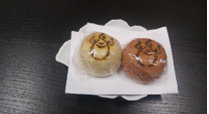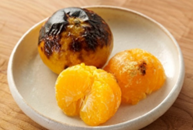During the winter fire festival and Ohitaki festival, grilled mandarin oranges and Ohitaki manju
Yoshie Doi

Ohitaki manju(Ohitake-san) |

Otama(Fire hieroglyph) |

Grilled mandarin orange |
In the cold season, oranges are the best fruit. Mandarin oranges contain vitamin C, which boosts immunity. It has been said for a long time that people who are sensitive to the cold and to prevent colds can warm their bodies by grilling the tangerine with the skin on a net and eating the pulp. In addition, if the peeled mandarin orange peel is dried in the sun, it becomes what is called chinpi in Chinese medicine, and it is also used in cooking. I also use tangerine peels to clean my kitchen sink, and it cleans well.
In Kyoto, it is customary from mid-November to early December to roast mandarin oranges and eat them with firewood manju at the fire festival. Companies that use fire, blacksmiths, casters, bathhouses, merchants that handle fire, and tea ceremony masters distribute Ohitaki manju to their employees and related parties during this season. In the old days, kotatsu and braziers were put out on this day.
The Ohitaki manju, which is made from new crops of adzuki beans and is branded with an otama (fire hieroglyph), is a representative offering of this season.
At Iriyama Tofu, who has been making tofu using fire every day for 200 years, Okudo-san will be offered mandarin oranges, sake, Ohitaki manju, and Iwaokoshi at this time of year. This is because Iwaokoshi sweets are also made from new grains and begin to appear at this time of year.
Since ancient times, it has been believed that Okudo-san is a place where the god of fire resides, and it is believed that eight million gods live in nature and surroundings. As a symbolic place to pray for respect and safety to Okudo-san, where the god resides, we offer Ohitaki manju and mandarin oranges.
After the day when the sun is at its lowest point and the energy that hits the ground is the weakest, the day when the power of the sun strengthens again is called “Ichiyo Raifuku Day.” In the lunar calendar (lunar solar calendar), the calendar starts from the winter solstice of the previous year. A grand feast called “Sakutan Toji” was held in the Imperial Palace.
At a time when we were incorporating the blessings of nature into our lives, we were sensitive to the strength of nature’s energy. In ancient times, it was believed that the emperor’s power would weaken during this season, and it is said that the fire festival began around the Edo period. There are various theories about the origin of the fire festival, but it is said that it originated from the Niinamesai (harvest festival), and it is a festival to offer the grains harvested at that time to the gods, thank them for the bountiful harvest, and thank them for the blessings of fire. In the early Showa era, this fire festival was held in each town of Kyoto. Today, it is mostly performed at shrines. At the Kyo-Suzume Culture and Tourism Research Institute, the time when the sun’s energy reaching our daily lives is at its weakest (the week before the winter solstice) is based on the ancient Chinese legend of the god of the hearth. For this reason, we are holding the Okudosan Summit as part of Okudosan Week. This year, on December 4th (Sun), on the same day as the Fire Festival, we will be using mobile Okudo-san to cook rice and hold the 4th Okudo-san Summit in the precincts of Wakamiya Hachimangu Shrine on Gojozaka. This year, we will launch the “Okudo-san Miraishu” and form a group that inherits the culture of fire, and will continue to make further efforts.
This year is also the season of Niinamesai and the winter solstice. Thank nature and thank fire to get through the cold season.
The end of document
